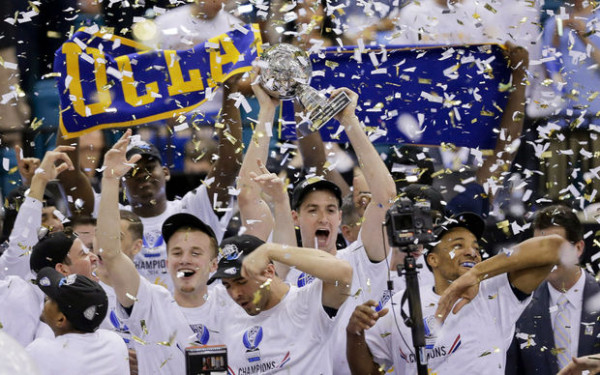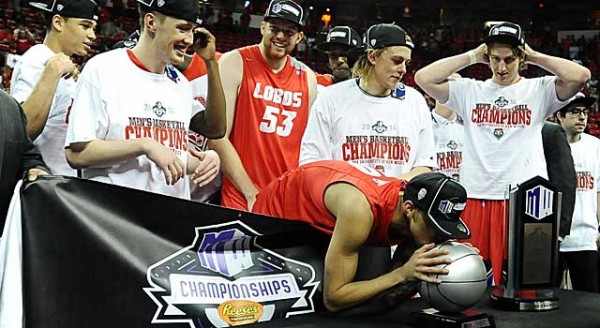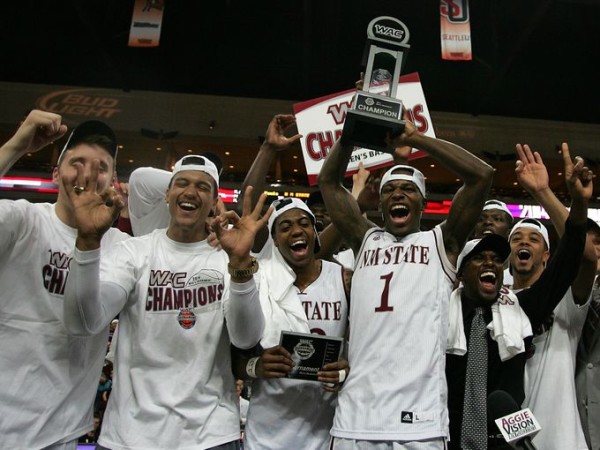Bracket Prep: UCLA, New Mexico, New Mexico State
Posted by Bennet Hayes on March 16th, 2014As we move through the final stages of Championship Week, we’ll continue to bring you short reviews of each of the automatic qualifiers to help you fill out your bracket next week. Here’s what you need to know about the most recent bid winners.
UCLA

Steve Alford’s Hire Was Met With Resistance Last Spring, But Less Than Twelve Months Later, He Has The Bruins Back On Top Of The Pac-12. Next Stop: NCAA Tournament.
- Pac-12 Champion (26-8, 15-6)
- RPI/Pomeroy/Sagarin = #21/#16/#16
- Adjusted Scoring Margin = +13.8
- Likely NCAA Seed: #4-#5
Three Bruce Pearls of Wisdom.
- In making Arizona look mortal for the first time all week in Vegas, UCLA became Pac-12 Tournament champions and earned the league’s automatic berth in the NCAA Tournament. UCLA has now scored 75 points against the Wildcats in both meetings this season, and since Michigan is the only other Wildcat opponent to score 70+ points on Sean Miller’s team, it’s an achievement worth noting. If you can score on Arizona, you can score on anyone, and UCLA looks likely to accomplish just that in the Tournament. Each member of Steve Alford’s eight-man rotation is capable of scoring in double figures on any given night, paced by leading scorer Jordan Adams (17.2 PPG, 2.7 SPG). The high game totals that the Bruins’ quick pace generates obscures what has actually been a pretty decent defensive effort (UCLA has the 49th best defense in the country according to Ken Pom), but there’s no hiding that it’s the hyper-efficient offense that makes the Bruins go.
- Kyle Anderson (14.9 PPG, 8.8 RPG, 6.6 APG) is a joy to watch on the court, but it might be even easier to appreciate him on KenPom.com, especially if you like to spend Saturday nights poring through free throw rates and true shooting percentages. The All-Pac 12 selection and Pac-12 Tournament MOP ranks in the top-500 in a whopping 12 of 15 individual categories on the site, with the only average categories being percentage of shots taken (who cares), offensive rebounding percentage, and turnover rate. Figuring out how many players have a similar variety in their statistical profile would take quite a while, but it’s difficult to imagine any player in college basketball even having ten of their fifteen categories among the top-500. He’s as proficient at cleaning the glass as he is setting up teammates, equally likely to knock down a three as he is to a shot block a shot. There will be only one Kyle Anderson is the 2014 NCAA Tournament, and that absurd Ken Pom stat-line is testament to just how diversely special he has been all season.
- Steve Alford is a massive part of the UCLA narrative heading into this NCAA Tournament. Alford has done a wonderful job in Westwood this season, but don’t think it’s nearly enough for him to outrun his shaky Tournament resume. Seeing is believing, and the latter will only happen with Alford after the former occurs. The reticence to trust the UCLA head man stems from Alford’s 3-6 Tournament record at Iowa and New Mexico, a mark that includes exactly zero Sweet Sixteen appearances and one nice ugly upset to #14 seeded Harvard just twelve months ago. Do you want to believe in Alford already? Hang your hat on the differences between this UCLA team and the eleven previous ones he coached at Iowa and New Mexico, because only one of those teams (2004 Iowa) finished among the top-100 teams in possessions per game (and still just 66th). The Bruins are currently 14th in the metric, and there’s little doubt that this is the most up-tempo, offensively efficient basketball team that Alford has ever coached.
Best Case Scenario: National Championship. Too much, you say? Trusting in Alford is a risky proposition this time of year, but if his Tournament track record is more a function of a small sample size than any inherent ineptitude with Alford himself, the sky is the limit for the Bruins. They have proven themselves capable of beating anyone, and this NCAA Tournament is wide open, which eliminates any reason why the explosive UCLA offense – with top-50 defense in tow – can’t become the story of the 2014 Tournament.
New Mexico

Kendall Williams Threw The Final Dagger, But Another Team Effort Pushed New Mexico To Their Third Consecutive Mountain West Tournament Title
- Mountain West Champion (27-6, 18-3)
- RPI/Pomeroy/Sagarin = #16/#28/#32
- Adjusted Scoring Margin = +10.9
- Likely NCAA Seed: #4-#6
Three Bruce Pearls of Wisdom.
- New Mexico’s regular-season ending loss at San Diego State not only gave the MW regular-season title to the Aztecs, but also had to leave Craig Neal’s squad wounded and angry. Losing a game after building a 14-point lead in the first 28 minutes (one that at that juncture, the Lobos were predicted to win 95% of the time) will never sit well, but the knife twists only deeper when that kind of thing happens against your biggest rival, in your season’s most important game. Those bad memories only made Saturday’s Mountain West title game that much more important for the Lobos, so consider their 64-58 MW Tournament-clinching victory yesterday a cleansing reset for a team looking more dangerous by the week.
- The Big Three of Cameron Bairstow (20.4 PPG, 7.3 RPG), Kendall Williams (16.4 PPG, 5.0 APG), and Alex Kirk (13.8 PPG, 2.8 BPG) are all pretty familiar names to college basketball fans at this point, but Bairstow and Williams are just two of four Lobos with an offensive rating among the 200 best in the country. Usage rates are significantly lower for Hugh Greenwood (O-Rating of 118.1) and Deshawn Delaney (O-Rating of 118.3) but both are capable of delivering key plays for the Lobos. Just look to Saturday’s title game for proof, when both players hit delirium-inducing threes in the final five minutes. Craig Neal’s bench production has often been non-existent in 2014 (the bench scored just four total points between Friday’s semifinal win and Saturday’s clincher), which only makes Delaney and Greenwood’s complementary roles to the Big Three that much more critical.
- Opponents shot more free throws than New Mexico in just five of their 33 contests this season. The Lobos live at the charity stripe, but they also make sure their opponent dies from free throw abstinence. It is one of the most eye-popping stats from an individual season full of them, but Cam Bairstow drew 7.5 fouls per 40 minutes (17th nationally), while only committing 2.6 fouls per 40 minutes (354th nationally). The ability of the bruising Aussie to draw fouls and get to the line is one thing, but for a big man to pair that skill with an extreme disinclination to foul (and his Blk% of 4.9 tells you it comes at no sacrifice to capable, aggressive defending) is remarkable. The feat is more manageable for a guard, but Williams’ FC/40 (2.1) and FD/40 (5.7) are also both among the 250 best in the country. There’s only so much you can do to keep the Lobo offense, and in particular Bairstow, off the line, but finding a way to minimize a free-throw discrepancy would be in the best interest of Lobo Tournament opponents.
Best Case Scenario: Final Four. The Lobos may have the best frontcourt in the country, and there are plenty of highly-regarded teams out there who have yet to be truly tested down low. Add in an experienced leader like Williams who doubles as a gutsy shot-maker, and the Final Four becomes an eminently attainable goal. The Lobos spotty recent track record in recent Tournaments may dissuade some, but the doubts have built a chip-on-the-shoulder mentality for this mentally-tough squad.
New Mexico State
- WAC Champion (26-9, 15-4)
- RPI/Pomeroy/Sagarin = #78/#72/#85
- Adjusted Scoring Margin = +7.9
- Likely NCAA Seed: #13-#14
Three Bruce Pearls of Wisdom.
- If you haven’t checked in recently on the WAC but manage to hold a pleasant perception of the league, stop reading now, and run far, far away! And don’t ever come back! The conference’s member list has undergone a transformation or fourteen since the opening of the century, and time has not served the league well. The good news emerging from Saturday night’s WAC final is that New Mexico State will again be serving as March ambassador for the league, while runner-up Idaho (16-18, RPI of 250)is set to join seven of the eight other WAC programs somewhere far away from your television sets for the rest of the month. The 2013-14 WAC season was definitely not always pretty for Coach Marvin Menzies’ Aggies, but despite losing out on the regular season crown, the Aggies were able to restore a bit of order in Vegas this week.
- New Mexico State is a good offensive team (43rd nationally in offensive efficiency) with a sneakily varied offensive attack, but there is one Aggie in particular that seems to draw constant attention. Nope, we are not talking about 2014 WAC Player of the Year Daniel Mullings (16.7 PPG, 4.8 RPG, 3.5 APG), but instead his significantly harder to miss teammate, 7’5” Sim Bhullar (10.2 PPG, 7.8 RPG, 3.5 BPG). Sim’s prodigious stature will always make him a wonder to behold for casual fans, but his impact goes well beyond that of a novelty item. Bhullar’s minutes are down slightly in this his sophomore season, but he has improved his offensive and defensive rebounding percentages (both rank among the 200 best in the nation), as well as both field-goal and free-throw shooting percentages (64% and 54% in 2013-14, respectively), while also blocking more than 11% of opponent’s field goal attempts during his time on the floor (22nd in the nation). In summation: the contributions, like the man creating them, have been massive.
- The 2013 New Mexico State Aggies (also a Tournament team) were the biggest team in the country, rebounded at both ends effectively, and hung their hat on defensive efficiency and toughness to overcome a run-of-the-mill offense. The 2014 Aggies are still the tallest in the country (thanks Sim), but don’t assume that the blueprint is the same as it was a year ago for Menzies and company. This team crushes the offensive glass (offensive rebound percentage=37.9%) but has surprisingly struggled to protect their own backboard (33.2% defensive rebounding percentage is 264th nationally), which is just one of a handful of Aggie defensive maladies. The end result is an average defensive team (130th in defensive efficiency) that relies on their offensive prowess – particularly from two-point range – to overcome those inefficiencies elsewhere. Almost across the board, these Aggies bear little resemblance to the team that preceded them.
Best Case Scenario: Round of 32. Menzies’ program is too familiar with the NCAA Tournament to be incapable of pulling an opening round upset (also see: December 17th win at New Mexico), but a run-down WAC has alternatively exposed (three losses to teams outside the RPI top-250) and obscured (easy WAC Tournament title, generous statistical profile) the reality that we have seen better New Mexico State teams in recent years, all of whom came up empty at the Big Dance.












































